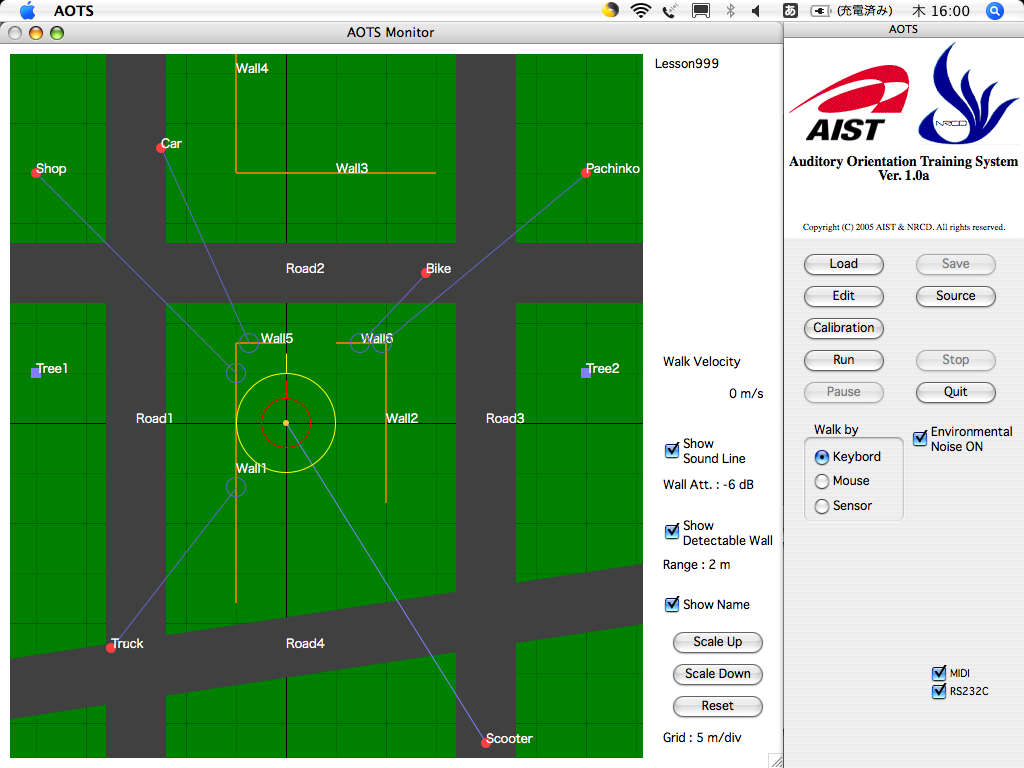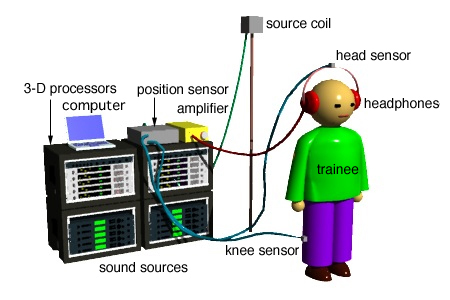Outline of study
Introduction
In order to walk or travel, the blind people should cognize space by using auditory obstacle perception, sound localization, etc. The auditory orientation is very important in O&M training of the blind. However, the beginners of auditory orientation may encounter dangerous situation if they train outdoors. To reduce the danger, the auditory orientation training in the virtual environment simulation is required in advance to the actual environment training. We are trying to develop the total training system of the auditory cognition in the virtual environment (Fig. 1) by using 3-D sound technology including HRTF (Head-Related Transfer Function).

Auditory Orientation Training System Ver. 1.0
Auditory Orientation Training System Ver. 1.0 was accomplished June 2005.


Specification
- Virtual sound environment is represented by 3-D sound technology. The trainee can experience the virtual environment where cars and/or buildings exist safely through headphone.
- Based on the information of head position sensor, the relative location of sound image in the virtual environment is controlled to move toward the opposite direction of head movement. This control makes the impression as if the trainee were in the fixed environment, and the trainee can learn the variation of ambient sound by the head movement.
- Based on the information of knee position sensor, the system detects "the stepping" movement. The trainee can walk through the virtual environment by the stepping movements.
- The system can conduct the training of not only the sound localization but also the obstacle perception by reproducing reflections and/or insulations.
- The training environment is described in original XML (DTD file of AOTS XML).
Collaboration
- Mr. Tetsuji Sato, Instructor, Course of Rehabilitation for Persons with Visual Disabilities, The College of National Rehabilitation Center for Persons with Disabilities, Japan (He is now with Japan Coast Guard).
Funds of Research
This study was partially funded by
Development of Auditory Orientation Training System for the Blind by using 3-D Sound,
(No. H15-Sensory-006)
Researches on Sensory and Communicative Disorders,
Health and Labour Sciences Research Grants (Japanese version only), 2003,
Ministry of Health, Labour and Welfare (MHLW), Japan.
References
- Yoshikazu SEKI, Tetsuji SATO,
A Training System of Orientation and Mobility for Blind People using Acoustic Virtual Reality,
IEEE Transactions on Neural Systems and Rehabilitation Engineering, Vol. 19 Issue 1, 95-104 (2011). - Yoshikazu SEKI, Tetsuji SATO,
Auditory Orientation Training System by using 3-D Sound for Persons with Visual Impairment,
Research Bulletin, National Rehabilitation Center for Persons with Disabilities, No.26, 9-13 (2007) (in Japanese). - Yoshikazu SEKI, Tetsuji SATO,
Development of Auditory Orientation Training System by using 3-D Sound,
The 14th Annual Meeting of Japanese Association of Rehabilitation for the Visually Impaired (2005) (in Japanese).
Patents
- Yoshikazu SEKI, Tetsuji SATO,
Environment Production System of Orientation & Mobility for the Persons with Visual Impairment.
, Japanese Patent No. 4534014

 National Institute of Advanced Industrial Science and Technology (AIST), Japan
National Institute of Advanced Industrial Science and Technology (AIST), Japan